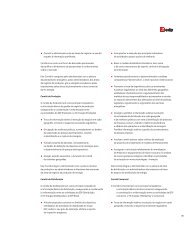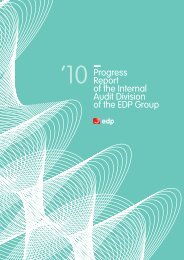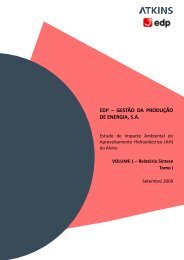Annual Report - EDP
Annual Report - EDP
Annual Report - EDP
- No tags were found...
You also want an ePaper? Increase the reach of your titles
YUMPU automatically turns print PDFs into web optimized ePapers that Google loves.
: strategic framework :Need for budgetconsolidation is the mainrisk to the North-Americaneconomy performanceDespite the slowdown presented at the end ofthe year, overall in 2012, the U.S.A. economyrecorded a slight growth over the previousyear. The private consumption growth remainedmoderate, constrained by the conservativegrowth of the real disposable income, along withthe still weak financial situation of households.Conversely, the level of investment presenteda dynamism not seen since the beginning of thefinancial crisis, benefiting specially from thereal estate sector recovery. The reduction of thetrade deficit as a result of a good performanceof exports and a significant increase of publicspending in the quarter preceding the presidentialelections, have also contributed positively to theGDP growth.Despite the reasonable performance of theeconomic activity, the economic climateexperienced in the U.S.A. in 2012 was shapedby a great deal of uncertainty induced by theso-called “fiscal cliff”, corresponding to theautomatic activation, scheduled for 2013, of thepublic spending reduction measures and theincrease of income taxes, with recessive impact.The implementation of these measures ultimatelyfailed to materialise, however the consolidationof public finances persists.The North American debt markets have benefitedfrom the risk aversion climate that prevailed inmuch of 2012, not only due to the aggravationof the European crisis but also because of thefear of domestic recession as a result of theimplementation of the budget contraction plan.However, despite this increased risk aversionenvironment, the North-American stock indexespresented considerable valuations, benefitingfrom the effects of the monetary stimulusmeasures announced by the Federal Reserve.USA (REAL GDP, INFLATIONAND UNEMPLOYMENT RATE)32101Q11 2Q11 3Q11 4Q11 1Q12 2Q12 3Q12 4Q12REAL GDP (YoY % CHANGE)UNEMPLOYMENT RATE (%)INFLATION RATE (%)2.1.2. energeticframework12840Source: BloombergThe recent publication of IEA’s World EnergyOutlook underlines the profound change thatthe world of energy is going through. Energyconsumption is expected to increase 33% by2035, with power consumption increasing morethan 70%, propelled by the rising urbanizationof emerging countries’ population and by thegrowing demand electrification in developedeconomies, penetrating new sectors of activitysuch as transports. On the supply side, a redesignof the energy dependency map is under way,in particular with the increasing production ofunconventional oil and gas in the United States.Renewable energies will be, however, the primaryenergy source with the highest growth in theworld – not only in Europe –, boosted by itsincreasing competitiveness, by its contributiontowards energy independence and by theimperative of decarbonizing economic activity.2012 ended with the Doha conference, in Qatar,where decisive steps were taken in the longnegotiation process to reach a global agreementto limit the emissions of greenhouse gases.CHANGE IN ELECTRICITY CONSUMPTION(2012 VS. 2011)-3.6Portugal-1.8Spain-0.8EU27-1.4USA3.5BrazilNote: The change in electricity consumption for the EU27 refers to the accumulatedvalue until Q3 of 2012 vs. 3Q of 20112012 was also shaped by the continuation of theslowdown of developed countries’ economies,which had already taken place in 2011.Consequently, a decrease in power and naturalgas demand was again felt, both in Europe andthe United States. The main emerging economies(China, India and Brazil) were not as impactedby the cooling of the global economy and thuscontinued to register an increase of their energyconsumption in 2012.The economic situation in Europe aggravatedthe existing overcapacity in some powermarkets, leading to negative economic resultsfor combined cycle natural gas turbine plants(CCGT), as is the case in the Iberian power market(MIBEL). Additionally, the economic crisis ledto the collapse of the CO 2price of the Europeanemission allowances market which, coupledwith the reduction of coal prices due to high USexports (given the production of shale gas), ledto higher competitiveness of power productionfrom coal over production from natural gas.This situation goes in the opposite directionof European energy policy objectives, namely inrelation to the fight against Climate Change, sincecoal emits around twice the CO 2when comparedto natural gas. Hence, there is currently a debateover the re-equilibrium of the CO 2market, leadingto the presentation of concrete proposals bythe European Commission to re-establish theprice signal to foster investments in low-carbontechnologies.At the regulatory level, the economic crisis also ledto strong pressure on European governments to taxthe power sector, through fiscal measures whichare generally discretionary and distort the regulatoryframework. This happened to an extent where thepower sector, traditionally regarded as defensive byinvestors, became cyclical. On the flipside, thereare also positive signs, with the highlight goingto the market reform recently approved in theUnited Kingdom. This reform sets out to attractthe necessary investments to decarbonize thesector, while ensuring the economic and financialequilibrium of back-up technologies that contributetowards security of supply.In respect to commodity prices, there werediffering dynamics, with oil prices remainingat the same levels as in 2011, coal and naturalgas prices in the U.S.A decreasing and Europe’snatural gas prices increasing.26A World Full Of Energy
















